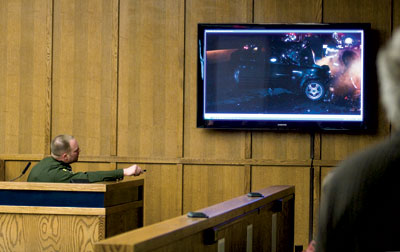The double homicide trial for Evergreen teenager Justine Winter began in earnest Tuesday, when the prosecution and defense presented opening statements and started delving into their extensive witness lists.
Winter, 17, is accused of intentionally driving her southbound car across the centerline of U.S. Highway 93, crashing into Erin Thompson’s northbound vehicle. Thompson, 35, and her son, Caden Odell, 13, were killed.
Based on the text messages sent between Winter and her boyfriend, investigators concluded that Winter drove into traffic in a suicide attempt, and charged her with two counts of deliberate homicide.
Appearing in court before District Court Judge Katherine Curtis, Winter sat with her attorneys and remained calm through the testimony, wearing a black jacket and a white headband with a bow and black polka dots.
Deputy County Attorney Lori Adams began her opening remarks by reading some of the text messages Winter sent her then boyfriend, which included threats of crashing her car and proclaiming that theirs was a life-or-death situation, before explaining that the two had fought and broken up just moments before.
“At that time ladies and gentlemen, (he) was the love of Justine’s life. She was 16 and it was a serious boyfriend for her,” Adams told the jury.
Six minutes after the teen sent her last text, Adams said, Winter crashed her car into Thompson’s near Church Drive on Highway 93.
In a trial that’s expected to take two weeks, Adams said the jury would hear from plenty of experts, officers and other witnesses involved with the case.
“All of the state’s evidence shows that the defendant caused the crash that resulted in the death of Erin and her son Caden and she did so knowingly,” Adams said.
Adams asked the jury to forget anything they might have ever heard about the case and approach it with a blank slate and the understanding that this is a very real situation, not “like your ‘NCIS’ or your ‘CSI’ or your ‘Law and Order’ shows.”
“The one thing that I want to make sure that you don’t check at the door … is your common sense,” Adams said. “You can’t decide this case on your emotions.”
However, Winter’s defense attorney, Max Battle, told the jury in his opening statement that the prosecution will highlight the tragedy of the deaths in this case, and also warned the jurors against basing their decision on emotion.
 |
|
Montana State Trooper Glen Barcus talks the jury through accident photographs during the Justine Winter trial in Flathead County District Court. |
Battle said that it is terrible two people died in this case, but “that doesn’t mean that the state has met their burden of proving that my client is responsible for this accident.”
He then told the jury that this case does not start or end with a text message between two young people, and that people often use hyperbolic language without meaning it literally.
“We don’t have enough homicides to account for the number of times a young girl says, ‘He’s to die for,’” Battle said.
Battle asked the jury to pay close attention to the evidence throughout the trial, evidence that he said would prove that it was Thompson who crossed the centerline that night, not Winter.
“What happened out there was an accident. It was an accident,” Battle said. “It happened in Justine Winter’s lane, not in Erin Thompson’s lane.”
The jury, made up of 10 men and four women, spent most of the day listening to testimony from Glen Barcus, the lead investigator with the Montana Highway Patrol.
Barcus, who responded to the March 19, 2009, crash, described how he examined and documented the scene, taking photographs and noting pre- and post-impact indicators, such as scrapes in the concrete.
The prosecutors presented dozens of photos from the crash scene and Barcus methodically went through each one, describing the different angles of the cars as they sat on the roadway and the scrapes, liquids and debris surrounding the vehicles.
The cars met on the Stillwater Bridge while it was still under construction near Church Drive and was a two-lane road. During his testimony, Barcus pointed to what he declared to be the point of impact in the northbound lane in front of Thompson’s car.
Barcus also noted that Winter’s speedometer had an orange “slap mark” on the hash near the 85 mph mark. This meant that the coloring on the speedometer’s needle transferred to the speedometer during the impact of the crash, Barcus explained. Later on, Battle asked Barcus a series of questions regarding the chain of custody for the speedometer and Winter’s seat belt, both of which were removed during the investigation.
During his testimony, Barcus said Winter’s seat belt did not appear to have been cut when she was extracted, nor did it have tears, rips or blood on it. It was also locked in the upright position, he said.
“My opinion is that Winter was not wearing her seat belt at the time of the crash,” Barcus said.
However, the next witness, Joseph Hansen of the Kalispell Fire Department, testified that he had marked on a report that Winter was wearing a seat belt based on information from other responders at the scene.
Thompson’s brother, Thaddeus Johnson, also testified on Tuesday and recounted the last phone message his sister left him. She invited him to Caden’s choir concert, Johnson said, and canceled a hair appointment she had with Johnson the following week.
Phone records presented in court showed that she called again at 8:19 p.m. on March 19, 2009, but Johnson said she didn’t leave a message.
“I wish I could’ve talked to her, that would’ve been awesome,” Johnson said. “Didn’t work that way.”
Kurtis Paulson, the Stillwater Bridge project manager for Knife River Corporation, also testified about the dimensions of the bridge.
The trial will continue on Wednesday at 9 a.m.